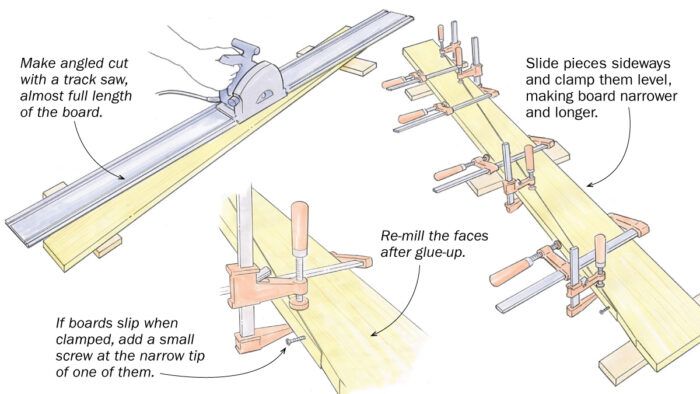Fresh take on board-stretching
If stuck with a board that's too short, use a long scarf joint and a track saw to stretch it.
I know I’m not the first person to cut a board too short, or have a piece of rough stock that’s a bit too short to start with. I’m also not the first person to “stretch” the board using a scarf joint, sliding the angled cuts to make the board longer and sacrificing some width in the process. But I think my method makes things easier.
The key is cutting a very long scarf joint, at the shallowest angle possible. This makes the pieces less prone to slipping sideways when clamped. And the secret weapon for making a long, smooth, straight cut like this is a track saw (though a bandsaw cut can be smoothed and straightened on the jointer). Make the cut almost the full length of the boards and then clamp as shown. If the cut is very long and shallow, the boards usually won’t slip when glued, but you can add a small screw to stabilize them.
The grain on your new board won’t match perfectly, but after you put it through the planer, the mismatch won’t be very noticeable with most woods. I used this method recently to make long stiles for a painted built-in, and it worked great as usual.
—JAKE WRYE, Knoxville, Tenn.
Illustrations by Dan Thornton
From Fine Woodworking issue #306
Fine Woodworking Recommended Products

AnchorSeal Log and Lumber End-Grain Sealer

DeWalt 735X Planer

Ridgid R4331 Planer





















Comments
Hmmm. Seems to me you could also use the reverse of this technique to widen a narrow board (as long as it was longer than needed).
This is a nice trick to have in the toolbox. It should best with knot-free wood with fine, even, straight grain, like white oak, mahogany, bass wood, etc. or on any part that is painted or in a location where it is not very visible. I might be trying this shortly, thanks!
Log in or create an account to post a comment.
Sign up Log in